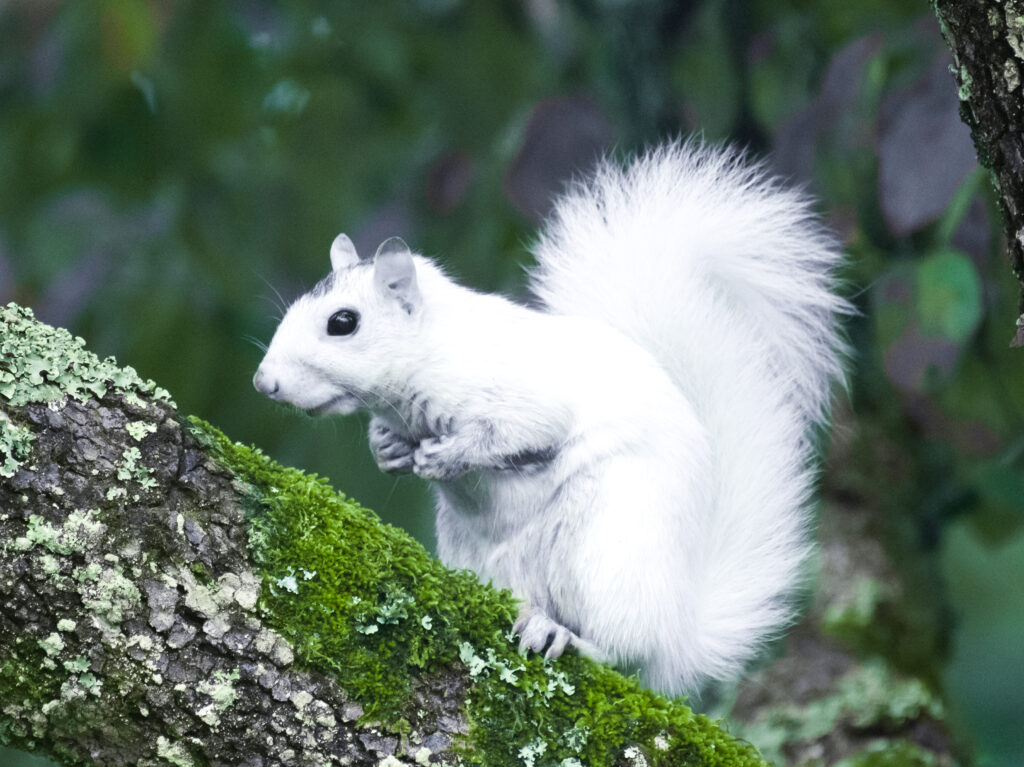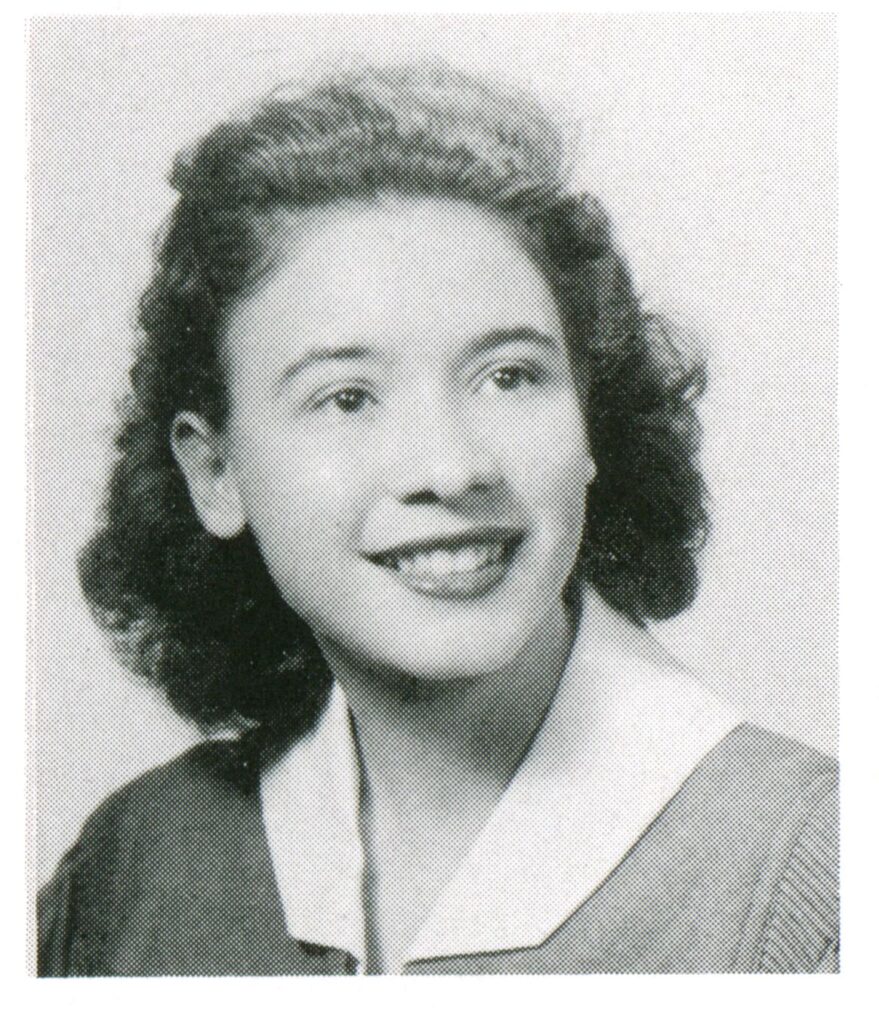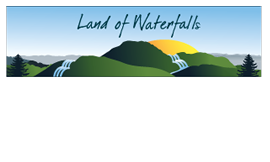
The unofficial mascot of Brevard, the white squirrel, is a novelty that many visitors initially think is a hoax. Surprise and delight result when a white squirrel is spotted for the first time, and many then become curious about the origin of these unique animals. The well-documented history of how the first pair of white squirrels arrived in Brevard is that they were given to Barbara Ann Mull by her uncle H.H. Mull in 1949. They were eventually released into the wild, where they presumably interbred with local gray squirrels and multiplied.
According to Mull family stories, the white squirrels originally came from Hawaii. A carnival man was traveling from the islands to Madison, Florida where the caravan turned over and two squirrels escaped. The squirrels took up residence in a pecan grove owned by M. M. Black (a friend of H.H. Mull). The white squirrels were thriving and multiplying so much that Mr. Black began to catch and sell pairs of them. H.H. Mull was given a pair in 1949, which he then gifted to his niece Barbara. She had hoped that the squirrels would breed, and offspring could be sold, but it seemed that they wouldn’t reproduce while in captivity. She named the female Snowball and the male Frisky. The squirrels were kept in a large outdoor cage and were fed tidbits and treats, but never really seemed to become tame.
In 1951, Barbara’s father was transferred to another state for work. Their new living situation would not allow Barbara to have pets, and so she gave the squirrels to her grandfather W.P. Mull, who lived on Johnston Street. One squirrel escaped during feeding time, and the remaining squirrel was so listless by itself that he released it into the wild too. Although Barbara was upset at the loss of her pets and believed they wouldn’t survive in the wild, surprisingly people would occasionally tell her about spotting the squirrels, though these pets-no-longer were too wild to recapture. The white squirrels populated Johnston and then Maple streets and spread further and further throughout the county. In 1986 a city ordinance was passed that designated the Brevard city limits as a squirrel sanctuary. All squirrels, but especially the Brevard white squirrels, are protected. It is “unlawful for any person to hunt, kill, trap, or otherwise take any protected squirrels within the city.”

Their success is a bit surprising, because one might assume that their striking coloration would make them easy targets for predators. Although it is not entirely certain why, a few theories explain the white squirrels’ thriving population here in Brevard and surrounding areas. One theory is that a major source of squirrel fatalities is automobile impact. White squirrels are more visible to motorists, and thus are less likely to be hit by cars. Another theory is that humans favor and protect white squirrels. For example, they are more likely to allow them to feed at a bird feeder instead of shooing them away, as may happen with common gray squirrels. Some even purchase extra treats and enjoy feeding white squirrels on their property. And lastly, it has been suggested that the white coloration is something that predators don’t “recognize” as prey. A colloquial story supporting this is a visitor who brought her dog to Brevard and noted that the dog would enthusiastically and frequently chase gray squirrels but didn’t seem to notice the white squirrels at all.
As white squirrels became more and more popular, a local professor took interest and saw an opportunity to study them more fully. The White Squirrel Institute was started by Robert Glesner in 1997. He was an Associate Professor of Biology, Emeritus, Brevard College. B.S., University of Maryland (Zoology); M.S. (Zoology) and Ph.D. (Biological Sciences), University of Michigan. He rallied college students to start the first annual White Squirrel Count, which continues into the present. This tally has shown that the white squirrel population makes up an astounding third of all the squirrels in Brevard city limits. What started as a guided research project for college students grew into an independent research initiative led by Dr. Glesner. The corresponding website for the institute is a treasure trove for information about the biology of these unique creatures and was utilized for this article. It can be found at https://whitesquirrelinstitute.org. Although Dr. Glesner passed away in 2013, the institute and his research live on with sponsorship from the Heart of Brevard. Here are a few interesting facts about white squirrel biology, as discovered by Dr. Glesner:
- White squirrels in Brevard are not albinos. Albinism is a lack of pigmentation in an animal. This means an albino animal will be all white with pink eyes, as they lack the melanin for dark eyes. Brevard’s white squirrels have dark eyes and a distinctive pattern of darker coloration that includes a head patch and a dorsal stripe that widens at the shoulders. The shape of the head patch can vary and may be inherited.
- White squirrels are the same species as gray squirrels, technically known as Sciurus carolinensis. The white squirrels are displaying a variation of color pattern which defines them as “leucistic”. This means they have reduced pigmentation, not the complete absence of it. Gray squirrels have a white belly (to make them less visible when viewed from underneath against a bright sky) and are mostly gray otherwise. With white squirrels, it’s almost as if that white belly coloration has extended to most of the body, leaving a small stripe as the only presence of dark fur coloration.
- There is a gene that determines which color pattern each squirrel will have, which is a dominant gene. If it were recessive, there wouldn’t be as many white squirrels as there are. Siblings can be gray or white, due to the fact that female squirrels can have offspring from more than one father within the same litter. Color does not seem to factor into mating preferences, and family bonds matter more than coloration when squirrels are defending territory.

- The origin of the squirrels is probably not Hawaii, as Mr. Black in Madison, FL suggested when he trapped and sold white squirrel pairs. Dr. Glesner commented skeptically on the origin story of the white squirrels and stated that there are no native terrestrial animals in Hawaii. There is evidence to suggest that a native population of white squirrels had been in that pecan grove as a natural occurrence of the area, and their prolific nature presented Mr. Black with an economic opportunity that would be enhanced if he could convince potential buyers that the animals were exotic. Many articles from northern Florida in the 1930s indicated that sightings of non-albino white squirrels were occurring with some frequency there and in other parts of the country, including Ohio, Illinois, and Texas.
White squirrels continue to thrive and be celebrated in Brevard and surrounding areas. These unusually colored animals have become an iconic symbol of the town and will hopefully continue to delight residents and visitors alike for many decades to come. Photographs and information for this column are provided by the Rowell Bosse North Carolina Room, Transylvania County Library. This article was written by Local History Librarian Laura Sperry. For more information, comments, or suggestions, contact NC Room staff at [email protected] or 828-884-1820.



